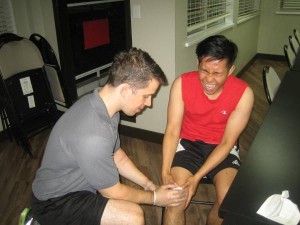A knee injury occurs as a result of damage to the knee structures caused by an accident or any other form of physical trauma. A knee injury may occur due to damage to the tendons, cartilage, ligaments, muscles or bone. Common injuries to the knee include knee sprains, knee fractures and knee contusions.
Important Disclaimer: the material posted on this post on knee injuries is for information purposes only. To learn to recognize and manage muscle, joint and bone injuries enrol in a workplace approved first aid course (more information).
Causes
Common causes of knee injury include:
- Running
- Falls
- Sports injuries
- Occupational injuries
- Motor vehicle/car accidents
- Weight lifting
- Stepping on a lowered or uneven surface without knowing/looking
Types of knee injury
Knee injuries are classified as follows:
- Knee fracture
- Knee dislocation
- Knee stiffness
- Knee sprain
- Knee contusion
- Patellar tendon rupture
- Lateral collateral knee injury
- Medial collateral knee injury
- Quadriceps tendon rupture
- Anterior cruciate knee injury
- Posterior cruciate knee injury
- Medial meniscus knee injury
Signs and symptoms
Signs and symptoms of a mild knee injury include:
- Mild pain in the knee
- Mild bruising
- Mild swelling of the knee
- Mild tenderness of the knee
- Mid stiffness to the knee
- Mild pain or discomfort while standing up or walking
Major signs and symptoms of severe knee injuries include:
- Severe bruising on the knee area
- Severe knee pain
- Severe wounds on the skin such as lacerations, abrasions and puncture wounds
- Inability to walk
- Inability to stand up
- Inability to move the affected knee
- Deformity of the knee
- Knee pain worsens
- Swelling worsens
- Unilateral weakness of the knee – below the knee
- Unilateral numbness of the knee – below the knee
Treatment
If you are suffering from a severe knee injury, seek immediate medical help or call for an ambulance immediately.
In case of a mild knee injury, follow these steps:
1. Control swelling using the RICE method:
- Rest the affected knee. Do not use the affected knee and rest until symptoms such as pain and swelling disappear
- Ice the affected region using an ice pack
- Compress the affected region using an elastic gauze or elastic sleeve
- Elevate the injured knee whenever possible, especially while resting
2. Treat symptoms of the condition
- Symptoms such as swelling can be controlled with the rice method. For pain, you can take over-the-counter pain medication such as acetaminophen or ibuprofen. Avoid taking NSAIDs if there is any severe bleeding and avoid giving aspirin to children and teenagers under 18 years of age. See you doctor if pain is too severe
When to seek medical help
See your doctor if:
- Pain still persists for more than 2 weeks even with home treatment
- If the knee shows changes such as increased warmth
- If you are suffering from a fever along with pain and swelling of your knee
The doctor will examine the affected knee with X-rays or other means of imaging. He doctor may prescribe medication such as anti-inflammatory drugs and perform treatment measures such as physical therapy, fluid drainage, braces or crutches. Surgery may be needed in case of a severe injury such as a knee joint dislocation.
If the doctor has placed your knee in a splint or a cast, seek medical help if any of the following occur prior to the medical treatment:
- Unilateral worsening foot pain
- Unilateral worsening leg pain – under the splint or cast
- Pale toes
- Numbness of the foot
Related Video

